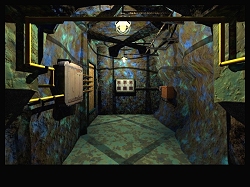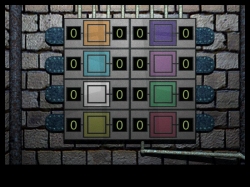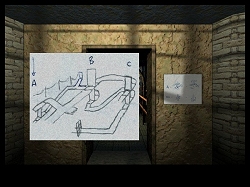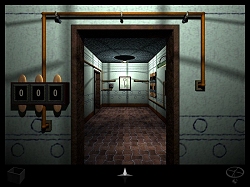|
RHEM 2: The Cave
 The original RHEM was an excellent independent game release, a back yard job if you will, that proved that a game need not have flashy graphics and a strong story in order to provide a challenging and satisfying adventure. Not even a soundtrack was present. The puzzles were the thing, not a backdrop with little puzzles tacked on here and there, but a great big puzzle of a world that had to be painstakingly picked apart, little piece by little piece.
The strength of RHEM can be seen in that it went on to gain a commercial release. Now it's back, and it's more of what made the first game so good.
RHEM 2: The Cave is part of the same world you visited in RHEM, although playing the first game is not necessary; remember, the plot ain't the thing. In the first game you explored a surface part of RHEM. In RHEM 2 you are in the caves beneath the surface world. There is a thin connecting story about your efforts, but that's about it. More than that isn't necessary.
Venture into these caves and discover some real gems.
I confess I at first found the caves a little claustrophobic. I preferred the open air feel of the first game. But it soon got lost in the puzzling wash.
I remember RHEM having lots of pipes. Well there are lots of them in RHEM 2: The Cave also, although much smaller, conduits if you will. Plus cables and switches and buttons and panels and levers, and things that go up and down and turn around... and little trains.
There is one big pipe, and it caused me major palpitations, but more of that later.
This is not a game to be rushed, and haste will be your worst enemy. It's a big place, and taking it apart is a mega task. It is certainly a difficult game, and I needed help in places. More so in the second half, and it seemed like a game of two halves in more ways than one. The original RHEM was an excellent independent game release, a back yard job if you will, that proved that a game need not have flashy graphics and a strong story in order to provide a challenging and satisfying adventure. Not even a soundtrack was present. The puzzles were the thing, not a backdrop with little puzzles tacked on here and there, but a great big puzzle of a world that had to be painstakingly picked apart, little piece by little piece.
The strength of RHEM can be seen in that it went on to gain a commercial release. Now it's back, and it's more of what made the first game so good.
RHEM 2: The Cave is part of the same world you visited in RHEM, although playing the first game is not necessary; remember, the plot ain't the thing. In the first game you explored a surface part of RHEM. In RHEM 2 you are in the caves beneath the surface world. There is a thin connecting story about your efforts, but that's about it. More than that isn't necessary.
Venture into these caves and discover some real gems.
I confess I at first found the caves a little claustrophobic. I preferred the open air feel of the first game. But it soon got lost in the puzzling wash.
I remember RHEM having lots of pipes. Well there are lots of them in RHEM 2: The Cave also, although much smaller, conduits if you will. Plus cables and switches and buttons and panels and levers, and things that go up and down and turn around... and little trains.
There is one big pipe, and it caused me major palpitations, but more of that later.
This is not a game to be rushed, and haste will be your worst enemy. It's a big place, and taking it apart is a mega task. It is certainly a difficult game, and I needed help in places. More so in the second half, and it seemed like a game of two halves in more ways than one.
 Arrive at the cave system and start pressing buttons. Or at least try. Then walk around. And keep walking. Discover rooms, rotating shafts, ladders and doors. Things go up, other things come down. Some things open, and others won't. Pipes go in here and come out there. Different coloured pipes too. Follow them and see where they go. Make some connections, power up some objects. Press some more buttons, raise some panels, pay attention to cause and effect, and start to draw things together.
It's a tangled place, but not (at least initially) as tangled as the first game. And cause and effect seem a little more closely related. So in that sense RHEM 2 is a better construct, but certainly not easier.
You need to have patience. You have to explore, you have to take notes, you have to observe. You have to recognise what is connected to what; a panel slid up to reveal something down below might have obscured something up above. Opening things can be less helpful than closing them. Spatial orientation can be very important, as can direction, helped by a little compass at the bottom of the screen. Absolutely nothing is insignificant (seriously).
If you are like me you will do nothing except look around for quite a while. Albeit only the first part of the cave system, it's still a big and convoluted place. You will have plenty of scribbles before too long. But in those scribbles will be the clues you need to move forward. Arrive at the cave system and start pressing buttons. Or at least try. Then walk around. And keep walking. Discover rooms, rotating shafts, ladders and doors. Things go up, other things come down. Some things open, and others won't. Pipes go in here and come out there. Different coloured pipes too. Follow them and see where they go. Make some connections, power up some objects. Press some more buttons, raise some panels, pay attention to cause and effect, and start to draw things together.
It's a tangled place, but not (at least initially) as tangled as the first game. And cause and effect seem a little more closely related. So in that sense RHEM 2 is a better construct, but certainly not easier.
You need to have patience. You have to explore, you have to take notes, you have to observe. You have to recognise what is connected to what; a panel slid up to reveal something down below might have obscured something up above. Opening things can be less helpful than closing them. Spatial orientation can be very important, as can direction, helped by a little compass at the bottom of the screen. Absolutely nothing is insignificant (seriously).
If you are like me you will do nothing except look around for quite a while. Albeit only the first part of the cave system, it's still a big and convoluted place. You will have plenty of scribbles before too long. But in those scribbles will be the clues you need to move forward.
Untangling the world is a challenge made up of little steps. The steps for the most part came regularly, and only occasionally did I feel completely lost. Certainly I had to review my notes, go over what I had done, and retrace my steps, but little solutions lead to another insight, or provided another clue that went into another puzzle that provided a further solution, and so on.
Each little triumph is a reward in itself. I felt periodically elated as I moved along.
The puzzles are exceptionally well crafted. It's often not just a question of finding the right clue, it's recognising that it is indeed a clue to a particular puzzle. None of the puzzles seemed like tired old staples of the adventure genre, although there are, of course, familiar elements.
Colour does play an important part, and whilst on the whole these are easily differentiated, on one occasion I opened a door whereby recognising the colour code but then repeating it tested my limits of colour perception. Brightness can be an issue too, and you may need to turn up your monitor.
 I was impressed when I reached the second part of the RHEM 2 cave system. Quite honestly, if it had finished there it would have still been a satisfying value for money effort, particularly given the shortness of some recent releases. It took me many hours over several weeks to get that far. But ahead was what turned out to be an even bigger place to explore.
The second part is relatively self contained, and the clues for the puzzles here will be found within its caverns and structures. Towards the end you do have to return to the first part, and you will be required to go back and forth a little, and some items and actions in the second are needed to complete the endgame in the first. But apart from this, you can start taking notes afresh, and confine your ponderings to the new problems and their clues.
Which is probably just as well, because the second part is harder, and I also found it a little overwhelming at times, even bewildering. There are some very large puzzles, with clues and information collected from all over, and I found the size made the insights harder to discern. I always felt slightly unbalanced, the fog of uncertainty never quite lifting.
This doesn't mean I didn't reach solutions, just that I never felt completely on top of things.
I did think some more clarity in places would have helped alleviate that feeling. Whilst I loved the turning huts puzzle, I failed to pick an objective, not even realising there was (another) one. I also missed getting some key information because I failed to do something that never even occurred to me to do. And I had no idea how to piece together the mathematical disk puzzle, even though I had most of the pieces of the answer. I confess that having gained help from a walkthrough, my reaction was one of "well, I would never have thought of that".
But many games have puzzles that bewilder, and if every puzzle was a piece of cake, well it wouldn't really be a puzzle. I kept plugging away, calling for help as need be, and made progress on my own sufficiently often, and constantly found new things to do and fiddle with, such that the enjoyment factor never waned.
I also missed one piece of information because I didn't look down at the relevant spot. Not finding stuff is more my own failing than a game design problem, but remember to search carefully. If you don't find something on the first passing, I suspect you may never find it given the size of the place and the lack of direct clues as to where to look. I was impressed when I reached the second part of the RHEM 2 cave system. Quite honestly, if it had finished there it would have still been a satisfying value for money effort, particularly given the shortness of some recent releases. It took me many hours over several weeks to get that far. But ahead was what turned out to be an even bigger place to explore.
The second part is relatively self contained, and the clues for the puzzles here will be found within its caverns and structures. Towards the end you do have to return to the first part, and you will be required to go back and forth a little, and some items and actions in the second are needed to complete the endgame in the first. But apart from this, you can start taking notes afresh, and confine your ponderings to the new problems and their clues.
Which is probably just as well, because the second part is harder, and I also found it a little overwhelming at times, even bewildering. There are some very large puzzles, with clues and information collected from all over, and I found the size made the insights harder to discern. I always felt slightly unbalanced, the fog of uncertainty never quite lifting.
This doesn't mean I didn't reach solutions, just that I never felt completely on top of things.
I did think some more clarity in places would have helped alleviate that feeling. Whilst I loved the turning huts puzzle, I failed to pick an objective, not even realising there was (another) one. I also missed getting some key information because I failed to do something that never even occurred to me to do. And I had no idea how to piece together the mathematical disk puzzle, even though I had most of the pieces of the answer. I confess that having gained help from a walkthrough, my reaction was one of "well, I would never have thought of that".
But many games have puzzles that bewilder, and if every puzzle was a piece of cake, well it wouldn't really be a puzzle. I kept plugging away, calling for help as need be, and made progress on my own sufficiently often, and constantly found new things to do and fiddle with, such that the enjoyment factor never waned.
I also missed one piece of information because I didn't look down at the relevant spot. Not finding stuff is more my own failing than a game design problem, but remember to search carefully. If you don't find something on the first passing, I suspect you may never find it given the size of the place and the lack of direct clues as to where to look.
 Ah yes, the big pipe. I had in fact looked up this pipe very early on in the game, not appreciating it was the same pipe I was looking down much later. Not till I slid down it and found myself back close to the start of the game in terms of location did I realise, having spent ages getting to where I had been. I was instantly horrified at the thought of what had happened, Gord@k emotions flooding my well being, and I immediately reloaded an earlier save game. As it turned out it wouldn't have been too bad, but save yourself the angst and think twice about sliding down any pipes until you have to.
What else? The glass maze needs mentioning. I don't like mazes, but this isn't really a maze. It's very small, and you have a map, so wandering around working out where to go is not the (so called) challenge. The challenge here is that there are doors between rooms that need to be opened, and opening one closes another (there's that connectedness again), so manipulating the doors to access the required rooms is what it's about. I spent ages on this, determined to beat the thing, and felt hugely satisfied with my efforts.
There is one sound puzzle, so long as you recognise it as such, and sound is important, too, when you try things. You will come to adore the satisfying noise of a successful action as opposed to the "thunk" of another failed effort. Ah yes, the big pipe. I had in fact looked up this pipe very early on in the game, not appreciating it was the same pipe I was looking down much later. Not till I slid down it and found myself back close to the start of the game in terms of location did I realise, having spent ages getting to where I had been. I was instantly horrified at the thought of what had happened, Gord@k emotions flooding my well being, and I immediately reloaded an earlier save game. As it turned out it wouldn't have been too bad, but save yourself the angst and think twice about sliding down any pipes until you have to.
What else? The glass maze needs mentioning. I don't like mazes, but this isn't really a maze. It's very small, and you have a map, so wandering around working out where to go is not the (so called) challenge. The challenge here is that there are doors between rooms that need to be opened, and opening one closes another (there's that connectedness again), so manipulating the doors to access the required rooms is what it's about. I spent ages on this, determined to beat the thing, and felt hugely satisfied with my efforts.
There is one sound puzzle, so long as you recognise it as such, and sound is important, too, when you try things. You will come to adore the satisfying noise of a successful action as opposed to the "thunk" of another failed effort.
RHEM 2: The Cave uses a simple point and click interface, and plays from a first person perspective. There is a very small number of items to find and use. Cursors will indicate an action can occur, and directions you can turn. It utilises prerendered graphics, with little Quicktime animations throughout and the occasional video clip of a real person.
You can usually turn left or right from one spot, occasionally look up or down. It's a slide show effect, a la Myst, and whilst I would have liked some 180 degree panning in the turning huts room to help my orientation, and a little more peripheral vision in some corridors and shafts, it's a perfectly acceptable way to present an adventure game.
As I said earlier there is no soundtrack, but there is ambient sound which is all you need. The sound effects are quite well done; bang on things and hear an appropriate response, be it metal or wood. Like everything else, it may be to your benefit to pay attention to what you hear.
There are a limited number of save game slots (10), something about which I always wonder. I can see no earthly reason why a game should need to limit the number of times I want to save. You can't really do anything wrong here, or at least nothing you can't undo, so restoring earlier saves is unlikely. However, if you like to create save games at key images to examine them later if need be, then you will be tested here.
Curiously, the save game records the playing time elapsed, but it isn't cumulative. So each time you start, even if you play from a single saved point, it will only record the current playing time elapsed. I can't see why it would do that, unless it is to remind us that we have been playing for two hours and, perhaps, had better have a break.
There are instructions for a full install, which I did, and there was no lag, no disk swapping, and no glitches or bugs. Everything played as it should, but if it doesn't you can bet Knut will fix it if at all possible. His after sales service has always been top notch.
It's all about the puzzling, and it's damn fine. It doesn't lead you by the nose and gives you lots to think about. Breakthroughs often lead to other insights and on you go. I did need help, and slapped myself sometimes for being so dense. Other times I simply applauded a very good puzzle. Almost everything is intuitive, there to be teased out if you take the time to ponder.
It's a holistic piece of gaming goodness (and the end suggests there is more to come!)
Copyright © Steve Ramsey 2005.
All rights reserved.
System Requirements:
Windows 98/2000/Me/XP, Pentium 600 Mhz or faster, 128 MB RAM, 100 MB disc space, CD ROM, 800 x 600 resolution, 32 bit colour, Quicktime 6 or above (comes on disc).
Mac OS (.x or OSX 10.2 or higher, 300 MHz or faster (G3 G4 G5), 64 MB RAM, 100 MB disc space, CD ROM, 800 x 600 resolution, 32 bit colour, Quicktime 6 or above.
|

